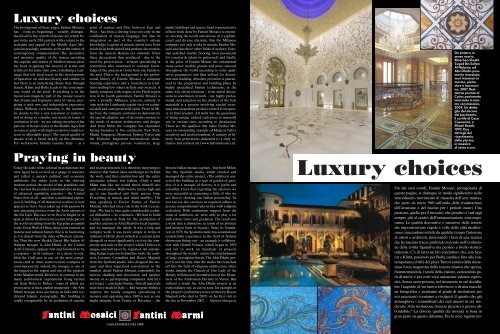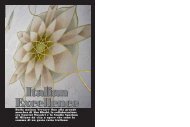PUBBLI FANTINI CV4DEF - Fantini Mosaici
PUBBLI FANTINI CV4DEF - Fantini Mosaici
PUBBLI FANTINI CV4DEF - Fantini Mosaici
- No tags were found...
Create successful ePaper yourself
Turn your PDF publications into a flip-book with our unique Google optimized e-Paper software.
Luxury choicesThe protagonist of these pages, <strong>Fantini</strong> <strong>Mosaici</strong>,has – from its beginnings – notably distinguisheditself in the rebirth of mosaic art, which beganin the early 20th century with a return to thearchaism and appeal of the Middle Ages. Mosaicsincreasingly continue to be at the centre ofcontemporary ornamentation. The decorativeand narrative quality of the tessera enrichingthe cupolas and domes of Mediterranean citieshas been re-igniting the interest of artists andarchitects for some time now, revitalising a techniquethat left deep traces in the developmentof figurative art and also history and culture. Infact there is an underlying theme that, throughSeurat, Klimt and Balla, leads to the contemporaryworld of the pixel. Everything is in themysterious magnetic pull of the mosaic tesserathat breaks and fragments unity of vision, energisingit with new and independent expressivevalues. Without even knowing it, the momentwe decide to buy a new television or camera –and in doing so consider our needs in terms ofresolution levels – we are asking ourselves whatpatrons of mosaic cycles in the Middle Ages hadto come to grips with: high resolution (small tessera)or affordable price? The varied quality ofmosaic work is based largely on this dilemma.For well-known historic reasons, Italy – as apoint of contact and filter between East andWest – has been a driving force not only in thecodification of mosaic language, but also itsintegration as part of the country’s artisanknowledge. Legions of mosaic artists have beeninvolved in both sacred and profane decoration,from the ancient Roman era onwards. Oftenthese decorations then produced – due to theneed for preservation – artisans specialising inrestoration who continued to transmit knowledgeof the ancient art form from one family tothe next. This is the background to the professionalhistory of <strong>Fantini</strong> <strong>Mosaici</strong>, a companyboasting experience and a rootedness in traditionrivalling few others in Italy and overseas. Afamily company with origins in the Friuli regionnow in its fourth generation, <strong>Fantini</strong> <strong>Mosaici</strong> isnow a proudly Milanese concern, entirely intune with the Lombardy capital vis-à-vis technicalskill and entrepreneurial spirit. From its Milanbase the company continues to demonstratethe special adaptive use of decorative mosaic tothe needs of modern architecture and design.And from Milan the company has expanded,having branches in five continents: New York,Miami, Singapore, Montreal, Sydney, Tokyo andthe Emirates. Important international showrooms,prestigious private residences, largePraying in beautyToday the scale of the colossal in architecture hasonce again been revived as a gauge to measureand reflect a nation’s political and economicambitions. For many years, in the thrivingmodern period, the model of the grandiose andthe vast was the peculiar communicative strategyof advanced capitalistic societies – the UnitedStates first of all – and then a traditional expressionin building of all dictatorial realities; it nowappears to have been taken up with passion bynew emerging powers, from the Arab nations tothe Far East. This race to be first in height, or inspan, is driven by diverse forces, but in the part ofthe world stretching from the Egyptian pyramidsto the Great Wall of China, deep roots connect anhistoric and cultural history that is as fascinatingas it is distant from the rules of Western rationality.Thus the new Sheikh Zayed Bin Sultan AlNahyan mosque in Abu Dhabi, in the UnitedArab Emirates, appears first and foremost to bea response – in its vastness – to a desire to establishthe Gulf area as one of the most conspicuous(and at times controversial) examples ofcontemporaneity: indeed, the mosque is one ofthe largest in the region and one of the greatestin the Muslim world. However, in contrast to themany architectural experiments being carriedout from Doha to Dubai – some of which areprovocative in their explicit modernity – the AbuDhabi mosque does not betray its links with traditionalIslamic iconography. The building istotally recognisable by its profusion of cupolasand soaring minarets. It is therefore surprising todiscover that Italian ideas and design are behindthe work, and that construction and the entiredecorative scheme was Italian. «Only a madMilan man like me would throw himself intosuch an adventure.Walls twenty metres high andup to one hundred and thirty metres long.Everything in mosaic and inlaid marble». Theman speaking is Enrico Fantin, of <strong>Fantini</strong><strong>Mosaici</strong>, who had a key role in the work’s execution.«We had to face quite considerable technicaldifficulties », he continues. «We had to builda joint venture in Italy for the production ofmarbles and one in Abu Dhabi for local logistics,and we managed the whole. It was a long andcomplex work; it was never simple in terms ofrelations with the client (which at a certain pointchanged) or more significantly vis-à-vis the complexityand scale of the project, which I believe isunique and will never be repeated. An outstandingItalian team was behind the work: the architectsLorenzo Carmellini and Rocco Magnolifrom the Spatium studio, who designed the mosqueand then supervised construction to thesmallest detail; <strong>Fantini</strong> <strong>Mosaici</strong>, responsible forinterior cladding and decoration; and anothertwenty or so participating companies. And let’snot forget », concludes Fantin, «that all materialsused were made in Italy ». And surprise within asurprise, the family company specialising inmosaics and operating since 1900 is not, as onemight imagine, from Venice or Ravenna – theCASA FONDATA NEL 1900public buildings and spaces, head representativeoffices: work done by <strong>Fantini</strong> <strong>Mosaici</strong> is extensive,meeting the needs and desires of a sophisticatedand diverse clientele. But the Milanesecompany not only works in mosaic; <strong>Fantini</strong> <strong>Mosaici</strong>also has three other fields of activity: Venetianpolished marble flooring, tiled pavementsfor courtyards (plain or patterned) and finally,in the guise of <strong>Fantini</strong> Marmi, the ornamentalstone sector: marble, granite and more, selectedthroughout the world according to strict qualitativeparameters and then utilised for decorationand cladding. Absolute precision is guaranteedin the preparation and building phase byhighly specialised <strong>Fantini</strong> technicians; in thesame way, client relations – from initial discussionsto conclusion of work – are highly professional,and selection on the market of the bestmaterials is a process involving careful screeningand scrupulous product control from quarryto final product. All work has the guaranteeof being unique: indeed each piece is manuallycut, in various sizes according to destination.These are the qualities that make <strong>Fantini</strong> <strong>Mosaici</strong>an outstanding example of Made in Italy’screativity and professionalism. A century of history:four generations dedicated to a truly exclusiveand refined art (www.fantinimosaici.it).historic Italian mosaic capitals – but from Milan,like the Spatium studio, which curated andmanaged the entire project. «The architects conceivedthe building as a type of garden of paradise.It is a mosque of flowers; it is joyful andcolourful. I feel that regarding the interiors wewere successful in expressing a little of who weare, that is, showing our Italian personality. Asyou can see, the exteriors, as required, adhere toprecise compositional rules in line with religiousorthodoxy. With continuous support from theteam of architects, we were able to play a lotwith colour tones and gradation. The result wasa work that is distinctive in terms of its abstractand modern form of beauty». Since its foundationin 1978, the Spatium studio has accumulatedconsiderable experience in the field of fashionshowroom fitting-out – an example is collaborationwith Gianni Versace, which began in 1979and led to work on hundreds of projectsthroughout the world – and in the refurbishmentof large, prestigious hotels. The Abu Dhabi projectis not the only time the studio has branchedoff into the field of religious architecture: otherworks include the Church of Our Lady of theRosary in Doha and reconstruction of the Monasteryof the Ambrosian Hermits in Varese. Butwithout a doubt the Abu Dhabi project is anextraordinary one, as can be seen, for example, inthe project’s preliminary notes written by RoccoMagnoli (who died in 2007) on his first visit tothe site in November 2002. Massimo MartignoniDa sinistra, insenso orario.Moschea SheikhZayed Bin SultanAl Nahyan, adAbu Dhabi: pavimentointarsiato;muri intarsiati inmarmo, pietredure e marmorino,2007. Residenzaprivata alCairo: pavimentointarsiato in marmocon mosaico,2004. Un dettagliodel decorodel pavimento.Il cortile di CasaCasuarina, aMiami Beach,1993. Duedettagli delrivestimentodella piscina,in mosaicodi vetro e oro.Luxury choicesFin dai suoi esordi, <strong>Fantini</strong> <strong>Mosaici</strong>, protagonista diqueste pagine, si distingue in modo significativo nellostraordinario movimento di rinascita dell’arte musiva,che parte da inizio ’900 sull’onda della rivalutazionedell’arcaismo e del fascino per i periodi oscuri. Unapassione, quella per il mosaico, che peraltro è tutt’oggisempre più al centro dell’ornamentazione contemporanea.Le qualità decorative e narrative delle tessereche impreziosivano cupole e volte delle città mediterraneeriaccendono infatti da qualche tempo l’interessedi artisti e architetti, rinnovando i fasti di una tecnicache ha lasciato tracce profonde non solo nell’evoluzionedella civiltà figurativa ma persino a livello storicoculturale.C’è di fatto un filo conduttore che, con Seurate Klimt, passando per Balla, conduce fino alla contemporaneaciviltà del pixel.Tutto è tenuto dalla misteriosaforza magnetica della tessera musiva che spezza,frammentandola, l’unità della visione, caricandola peròdi nuove e per certi versi autonome valenze espressive.Senza accorgercene, nel momento in cui decidiamol’acquisto di un nuovo televisore o di una macchinafotografica e pensiamo al grado di risoluzione pernoi necessario, torniamo a rivolgerci il quesito che giàattanagliava i committenti dei cicli musivi in età medievale.Alta risoluzione (tessere piccole) o prezzo abbordabile?La diversa qualità dei mosaici si basa ingran parte su questo dilemma. Per le note ragioni sto-




